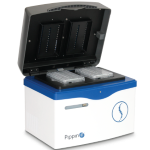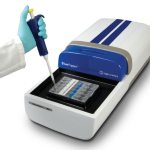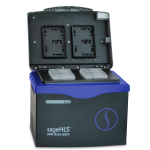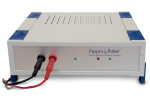If We Close Our Eyes, We Can Almost Hear the Sound of Surf
This winter has been especially brutal at Sage headquarters in Massachusetts — it is possible that we have never anticipated the Marco Island conference with quite this level of enthusiasm!
Next week we and hundreds of other scientists will flock to Marco Island, Fla., for the 15th annual Advances in Genome Biology and Technology conference. A quick look at the agenda promises that this year’s lineup won’t disappoint for big-name speakers, new technology details, and a continued push for demonstrations of clinical utility.
Aside from our big escape from subzero weather, we at Sage are excited about the meeting because it will be our opportunity to introduce new products of our own. The SageELF, short for Electrophoretic Lateral Fractionator, is the first whole-sample DNA fractionation system to hit the market. We think it has great applications for detecting splice variants, building libraries with multiple insert sizes for more accurate genome assemblies, and preserving precious samples. (It works with proteins as well.) We’ll also have a prototype of the high-throughput version of our Pippin automated DNA size selection system on display. Based on how many customers have been asking us for this, we can’t wait to show it off.
Feel free to stop by our suite — Lanai #281 — to check out the new products, learn more about how accurate DNA sizing can improve the quality of your experiments, or just pick up some of our cool swag. (Hint: there’s chocolate involved.)
We look forward to seeing you in sunny Florida!
At NYU’s Center for Genomics and Systems Biology, Pippin Allows for More Precise DNA Size Selection
At NYU’s Center for Genomics and Systems Biology (CGSB), the genomics sequencing core facility (GenCore) runs both infectious disease and model organism sequencing projects through its Illumina and Ion Torrent pipelines. In both workflows, they find Pippin Prep to be a handy tool for automated DNA sizing.
GenCore Manager Paul Scheid sees many different types of research projects come through the facility’s doors: de novo sequencing and double digest RAD-seq are two of the most common. GenCore clients are often studying the genetics and genomics of populations, not just an individual organism.
For both applications, Scheid says that Pippin automated sizing has been helpful to the lab, which has the HiSeq 2500, MiSeq, and PGM. The team uses Pippin for constructing regular libraries for de novo assembly, and also for tracking specific structural variants. “If we’re interested in eking out a specific indel and we want to be assured that that indel cannot possibly be created by a contiguous fragment in the population of fragments that go into library preparation, we can use Pippin to define a very narrow fragment range,” Scheid says.
The GenCore team also handles quite a bit of ddRAD-seq, a technique developed by the Hoekstra lab at Harvard. “We have a group that does a lot of ddRAD sequencing to isolate variants across the genome of their particular species of interest,” Scheid says. “We use the Pippin when constructing those ddRAD libraries to control the amount of loci that we hit from a given library. It’s very nice for fine-tuning that parameter.”
Automated size selection also works nicely with sequencing projects run on the PGM, “which is very sensitive to fragment sizes because of the emulsion PCR,” Scheid says. “So we use Pippin to make sure the libraries are in the exact range we want.”
Before getting the Pippin about a year ago, GenCore had several other methods for size selection. NYU CGSB decided to invest in the tool because it could accomplish things that the other methods couldn’t. “I just don’t think that there are any other platforms out there that allow the level of granularity that Pippin does in terms of size selection,” Scheid says.
Happy Holidays from All of Us at Sage!
Here at Sage Science headquarters in Beverly, Mass., we’ve already got visions of sugarplums dancing in our heads — so what better time to look back on the past year?
We are happy to report that 2013 was a great year for us and our customers. There have been several terrific publications released this year from scientific teams using Pippin automated DNA size selection. Here’s a small selection of not-to-be-missed papers:
Cheng et al. “Semiconductor-based DNA sequencing of histone modification states.” Nature Communications.
Bronner et al. “Improved protocols for Illumina sequencing.” Current Protocols in Human Genetics.
Love et al. “Selective Inhibition of Tumor Oncogenes by Disruption of Super-Enhancers”
DuBose et al. “Use of microarray hybrid capture and next-generation sequencing to identify the anatomy of a transgene.” Nucleic Acids Research.
Park et al. “An improved approach to mate-paired library preparation for Illumina sequencing.” Methods in Next Generation Sequencing.
We were also lucky enough in 2013 to spend time hearing about some truly fascinating work that are customers have been doing. If you haven’t yet checked them out, grab some eggnog and enjoy these customer profiles:
At TGAC, Pippin-Aided Sequencing Gives Quality Boost to Genome Assemblies
At Iowa Core Lab, Pippin Sizing Is Essential for MicroRNA Studies
At MIT, Pippin Enables Splice Variant Detection and MicroRNA Analysis
Tag Team: At DFCI, Pippin and Nextera Make Better Libraries
At Boston University, Pippin Makes Quick Work of ChIP-seq Prep
The year also saw more vendors including Pippin products in their recommended protocols, including Illumina (Nextera mate pair sequencing), Ion Torrent (exome enrichment), and Pacific Biosciences (long-read sequencing). Indeed, BluePippin really came into its own this year, with customers reporting that they could significantly increase throughput and average read length from their PacBio sequencers by using BluePippin sizing.
Our R&D team kept busy as well. We launched new cassette kits extending the selection range for BluePippin, cassettes with smaller elution wells for customers who prefer 25 µl output, our Pippin Pulse power supply for analytical gels, and our cassette for Epicentre’s ScriptSeq kit that boosts library diversity.
No wonder we’re ready for a little time off! We’ll rest up over the holidays and come back fully recharged and ready to bring you more great products and terrific science in 2014.
Happy holidays, everybody!
At Boston University, Pippin Makes Quick Work of ChIP-seq Prep
At Boston University, the Galagan lab is trying to get a complete picture of Mycobacterium tuberculosis — in particular, how the organism’s regulatory network functions. By methodically performing ChIP-seq on each transcription factor in the microbe, the scientists are using sequence data to determine which other transcription factors and genomic regions are expressed as a result. The ultimate goal: a comprehensive view of the complex interactions among these transcription factors across the whole TB genome.
The scientist behind the lab’s library prep is Chris Mawhinney, who says that using Pippin Prep for size selection in the ChIP workflow saves her time and eliminates the possibility of sample cross-contamination. Mawhinney performs size selection after adapter ligation and purification as she preps libraries for sequencing on the Illumina GAIIx. “If you have too broad a range of sizes, the sequencer software has issues locating the clusters,” she says. “And adapter-dimers will anneal to your flow cell and eat up your reads, wasting capacity.”
Mawhinney uses Pippin to select for 250 base pairs, which allows her to remove the low molecular weight content as well as larger fragments. “With Pippin Prep, you can get it down to a really nice, narrow size,” she says, noting that the tool is easy to set up and run.
In addition to the time savings of using an automated solution instead of a manual gel, Mawhinney says Pippin speeds up the sample prep routine because there’s no cleanup needed. “The great thing about Pippin is that you can go right from size selection to PCR; there’s no middle cleanup step, so it’s very convenient,” she adds. “That’s a huge plus and it saves a lot of time.”
Preventing contamination is also critical in a lab where samples are often used up completely during sequencing. Mawhinney treats each sample as precious, so she can’t afford to lose anything to contamination or to poor sizing. On Pippin, she says, “the channels are all separate, so that gets rid of the possibility of contamination.”
For more on the Galagan lab’s interrogation of transcription factors in TB, check out their recent Nature paper.
Sanger Reports Improved Prep Protocols for Illumina Sequencing
A new publication in Current Protocols in Human Genetics offers a thorough description of library preparation steps for sequencing with Illumina instruments. “Improved Protocols for Illumina Sequencing” comes from senior author Harold Swerdlow at the Wellcome Trust Sanger Institute and colleagues.
The detailed steps provided in the publication will “make the sequencing process more reliable in a high-throughput environment, reduce amplification bias, narrow the distribution of insert sizes, and reliably obtain high yields of data,” the authors note. The protocols described come from years of optimization studies at Sanger and represent the standard sequencing pipeline now used at the institute.
As many of our customers with Illumina sequencers know, size selection is an important part of the sample prep process. “Cluster amplification is a relatively inefficient process,” the scientists write. “Larger fragments [above 500 bp] up to 1,000 bp will cluster, but with increasingly lower efficiency and lower yield.”
Swerdlow and his colleagues use a variety of size-selection tools; when they need very tight sizing or are concerned about the generation of chimeric templates from the PCR step, they rely on our technology to perform accurate sizing. “Where a very precise/narrow size distribution is necessary, we recommend using Sage Science’s Pippin Prep,” they write. This figure from the publication shows why:
The scientists note that even in cases where especially narrow sizing is not necessary, performing a second size selection step with Pippin after running PCR is important for reducing chimeras. “This additional size selection reduces the incidence of chimeras from ∼5% to 0.02%,” they report.






